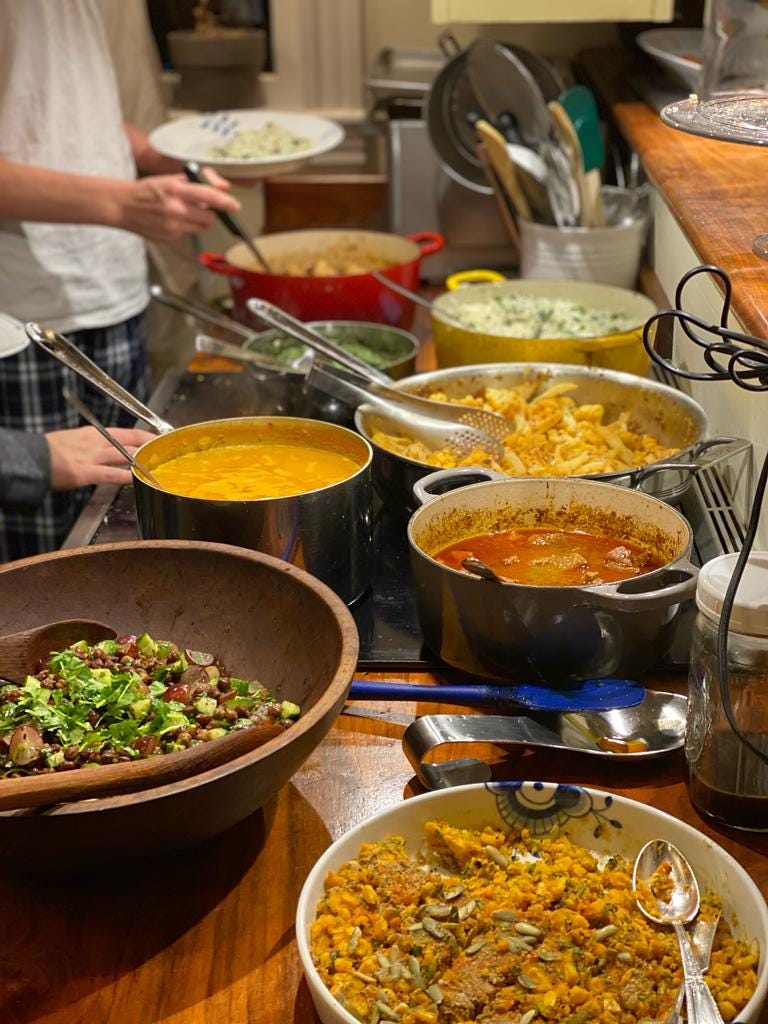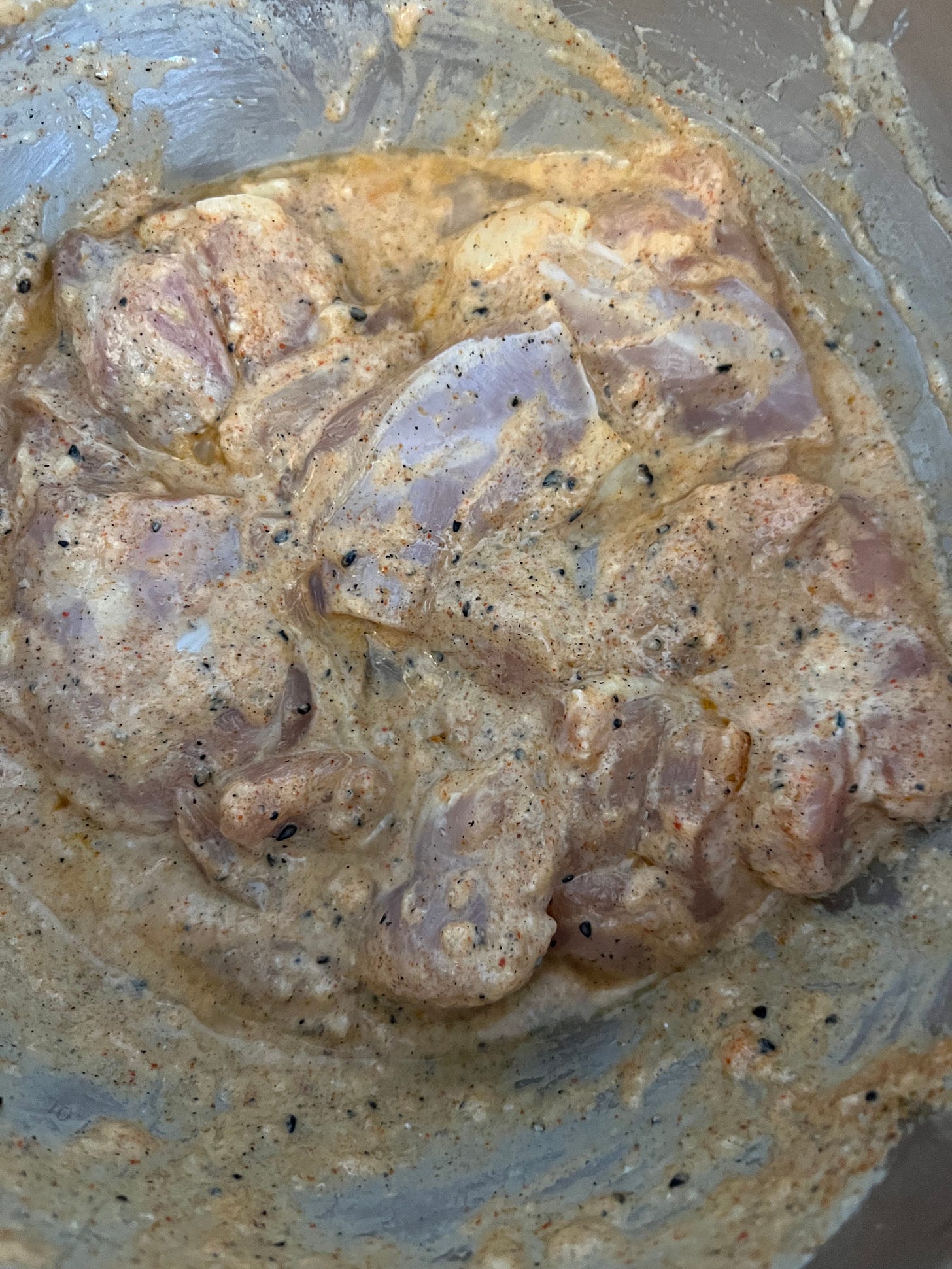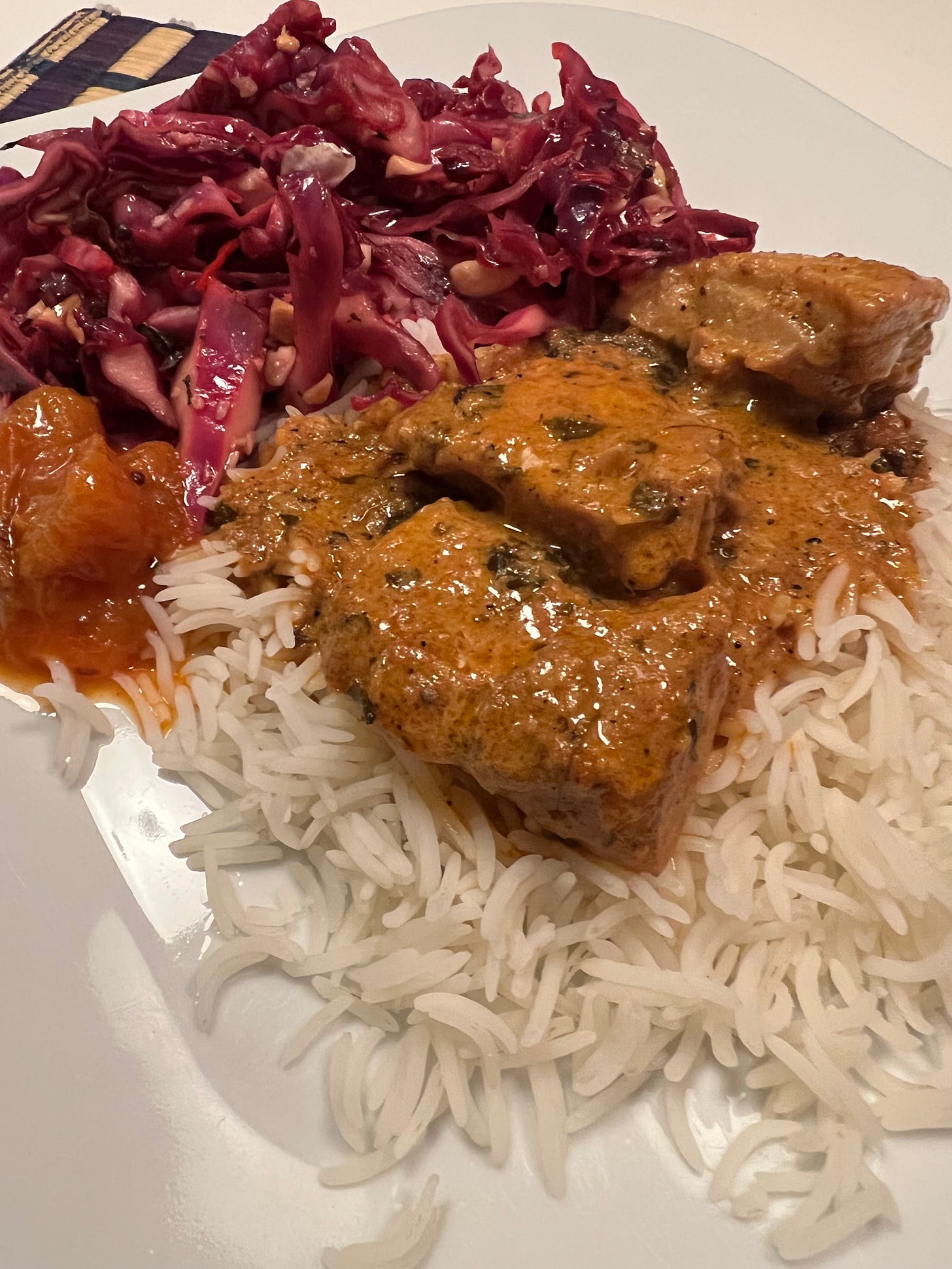Issue #78: A Different, Richer Bird
Authenticity in Recipes, A Debate Among Indian Cooks, Butter Chicken
Just off the heels of Thanksgiving, I’m writing this week from Miami, where our Aerobanquets RMX pop-up at Superblue Miami is a hit. The unique combination of food, art, and technology in this mixed-reality, immersive gastronomy experience by artist Mattia Casalegno, inspired by Marinetti’s Futurist Cookbook with a menu by chef Chintan Pandya, is the talk of Miami Art Week. It’s also the kind of other-world experience that has me thinking about the notion of authenticity and the way comfort foods ground us in our own realities.

Chicken Tikka Masala is to Indian food as Spaghetti and Meatballs is to Italian—that is, a globally beloved dish on the ersatz end of the authenticity spectrum from the perspective of their supposed countries of origin. Both dishes are derivative of actual foods consumed in India and Italy, respectively, resonant with local flavors and wildly popular around the world. But neither would necessarily be familiar to a native. Or so educated food writers are always eager to tell you.
I am fully aware of the cultural complexity of any notion of authenticity. While I spend a lot of energy in my kitchen making dishes from around the world that might be considered “authentic” by the food police, I do not necessarily value any version of something over anything else for the sheer reason of it being somehow more traditional of authentic. I think that all good cooks bring their own expertise and creativity to a dish, not to mention their personal tastes. I like to learn about traditional dishes and techniques to expand my repertoire and my skill. But the culinary merits of a dish for me are about how delicious it is, not how respectful of any abstract and often regressive notion of authentic it might be.
I love a good spaghetti and meatballs. And I have enjoyed many a delicious Chicken Tikka Masala.
In the last few weeks, though, I have truly fallen in love with the dish that many say is the culinary antecedent to CTM (as the Brits call Chicken Tikka Masala). I am fawning over Butter Chicken.
Rich in all senses of the word, Butter Chicken is the kind of dish that becomes a comfort food the first time you try it, no matter where or how you grew up. After making the recipe for Anita Jaisinghani’s Butter Chicken in her new Masala cookbook, my husband Nate gave me permission to put it in rotation. In the subsequent few weeks, I’ve made it many times for us and for company. If others were present, Nate would unsuccessfully try to convince our guests that the chicken was terrible and they were not going to like it, so he could have more for himself.

There seem to be at least as many opinions about butter chicken as there are Indians, more than a billion. From what I’ve heard and read, most Indian chefs have a memory of some delicious version of Butter Chicken from their childhoods. As already noted, I happen to be typing this newsletter from Miami, where I am helping produce a pop-up of our Aerobanquets RMX mixed-reality, immersive dining experience. The chef-partner of our new Flavor Five Studio production company is Chintan Pandya, the JBF-award winning, Michelin-starred chef of NYC’s hottest restaurants Dhamaka, Semma, and Adda. Chatting with Chintan late one night while we were getting the pop-up ready, he started ranting about those who confuse Butter Chicken with Chicken Tikka Masala, espousing how the former can rise to the level of a great dish as long as it is treated in the right way. He was particularly concerned about the quality of the tomatoes and the order of ingredients, including when the methi or dried fenugreek leaves are added (not at the beginning) and the cream is stirred in (toward the end). To Chintan, Chicken Tikka Masala, a British invention, is something else entirely.
I had deduced on my own that methi was a secret weapon in Butter Chicken, giving it a haunting, moreish flavor (as the Brits would say). The same weekend I made my first Butter Chicken, I also made a Persian braised lamb dish from Bonnie Stern and Anna Rupert’s new book, Don’t Worry, Just Cook. While one of the main flavors of that lamb comes from distinctive dried black Persian limes, there, too, I realized dried fenugreek leaves provided a beguiling background flavor to the braising liquid. I just bought a giant bag of dried fenugreek to experiment with it.
After seeing Butter Chicken in my Instagram feed so often, my friend Romy Gill, an Indian chef in London, who’s become a bit of a television celebrity and who received the coveted MBE from the Queen before she died, sent me a link to her article in the Guardian about this iconic dish. Romy writes how Butter Chicken helped her at every stage of her life. “For me, serving in my restaurant (it was one of the most popular dishes) allowed me to take people back to my roots—to taste the food I grew up eating. It’s one of the recipes that always fills me with nostalgia, and with hope, love power and knowledge at each step of my career.”
I’ll let the Indian chefs with real standing in this fight debate the details of a true Butter Chicken recipe amongst themselves. Here’s the easy and delicious recipe I am making in our house for the time being, inspired by Anita Jaisinghani, which she describes as “home-style.” Once you have the ingredients on hand, it cooks up in a flash. The only thing that takes time is the marinating, the longer the better. You can use chicken on or off the bone, but on has more flavor. I use Kashmiri chili powder which has an attractive bright red color and delicate flavor without too much heat. And I use my own tomato purée made from garden-ripened fruit. Find a good Italian passata (without basil) to use in place of an ordinary canned purée. There are no cashews or onions (two contentious points), though there are ground onion seeds (which one chef questioned). I don’t stir in extra butter and cream at the end because I find it already rich enough. But go ahead and add some more if you like. It may not be authentic, whatever that means. The only thing Nate and I know, is that this chicken is delicious.
RECIPE: Anita’s Butter Chicken
(Serves 4 to 6)
To Marinate the Chicken
½ cup plain, full-fat yogurt
2 tablespoons olive oil
3 cloves garlic, grated on a Microplane (about 1 tablespoon)
1 teaspoon Kashmiri chili powder
1 teaspoon ground, toasted cumin
1 teaspoon ground nigella seeds (kalonji)
1 ½ teaspoons kosher salt, divided
½ teaspoon freshly ground black pepper
2 pounds chicken thighs, skinned and cut into 2-inch pieces, on or off the bone
To Finish the Dish
¼ cup (4 tablespoons) unsalted butter
2 tablespoons ginger, finely minced or grated on a Microplane
3 cloves garlic, grated on a Microplane (about 1 tablespoon)
1 tablespoon Kashmiri chili powder
1 teaspoon sea salt
1 cup tomato purée, if you don’t have your own, use an Italian passata (without basil)
2 cups heavy cream
3 tablespoons dried fenugreek leaves (methi)
1 teaspoon garam masala
Begin by marinating the chicken. In a medium bowl combine the yogurt, olive oil, garlic, chili powder, cumin, ground nigella, salt, and black pepper and mix well. Add the pieces of chicken and stir to coat. Cover and refrigerate to marinate for at least 2 hours, but preferably 24 hours.

To finish the dish, preheat the oven to 450°F. Grease a baking sheet. Spread the marinated chicken pieces (generously coated with the marinade) on the prepared sheet and roast for 15 to 20 minutes until the chicken looks cooked and the juices run clear. Note, you will continue cooking the chicken in the sauce so it does not have to be fully cooked at this stage.
To make the sauce, in a wide, heavy-bottom saucepan, heat the butter over medium-high heat. Add the ginger and garlic and stir for a minute to cook. Add the chili powder, salt, tomato purée, and heavy cream and bring to a boil. Reduce the heat to simmer for about 10 minutes to thicken slightly and turn pink. Add the dried fenugreek leaves and garam masala and cook another 5 to 7 minutes, until fragrant.
When the chicken has finished roasting, add it to the sauce with any juices from the pan and whatever you can scrape off. Simmer for another 10 to 12 minutes, or until the meat is tender and the fat rises to the top. Turn off the heat and let the curry rest for about 15 minutes before stirring and serving.



